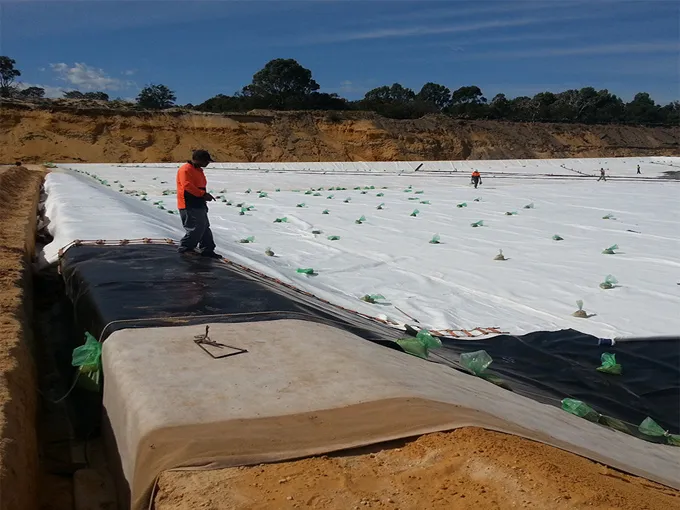When tackling construction or landscaping projects, two materials often come up: geotextiles and landscape fabrics. At first glance, they seem similar, which can lead to confusion. However, these materials have different purposes, applications, and performance requirements. Let’s break it down in simple terms to understand their similarities and key differences, so you can confidently choose the right one for your needs.
1. Introduction
As infrastructure projects and landscaping work grow in demand, picking the right materials is more important than ever. Geotextiles and landscape fabrics are both popular options, but using the correct one can make all the difference in achieving your goals. Knowing what sets them apart will help ensure your project runs smoothly, stays within budget, and lasts for years to come.
2. What Do Geotextiles and Landscape Fabrics Have in Common?
(A) Similar Materials
Both geotextiles and landscape fabrics are often made from synthetic fibers like polypropylene (PP) or polyester (PET). These materials are chosen because they’re flexible, durable, and resistant to wear and tear. Thanks to their shared material base, they have similar basic qualities, like being tough and long-lasting.
(B) Water Permeability
Another shared feature is their ability to let water pass through. Both materials have small pores that allow water to flow while stopping other elements like soil or debris. This makes them great for drainage systems or as ground coverings, helping to avoid water pooling while maintaining a healthy balance between water and soil.

3. How Are They Different?
Now that we know what they have in common, let’s explore what makes them unique.
(A) Their Main Functions
Geotextiles:
Geotextiles shine in construction projects. Think of them as the backbone of stability and protection. For example:
Reinforcement and Protection: In road construction, geotextiles are placed under the roadbed to distribute weight evenly and prevent soil movement. This keeps the road strong and stable, even under heavy traffic.
Filtration: In retaining walls or drainage systems, geotextiles act as a filter. They allow water to flow while holding back soil, ensuring the structure stays intact without losing ground material.
Landscape Fabrics:
Landscape fabrics are the go-to for gardening and landscaping. Their primary purpose is to improve the look and health of your green spaces. For instance:
Weed Control: These fabrics block weeds from growing while allowing your plants to thrive. They save time and effort by reducing the need for constant weeding.
Aesthetic Appeal: Unlike geotextiles, landscape fabrics often come in various colors and textures, making them blend seamlessly into the environment. They make gardens and yards look neat and polished.
(B) Performance Standards
Geotextiles:
Since geotextiles are used in large-scale engineering projects, they must meet strict performance standards. For example:
Strength: Geotextiles must handle heavy loads without tearing. Whether it’s under a road or a dam, they need to stay strong to support the structure.
Durability: These materials must withstand pressure from all directions and stay intact for years.
Landscape Fabrics:
Landscape fabrics have simpler requirements. They focus on:
Thickness and Weight: These factors determine how well they block weeds.
Appearance and Longevity: They should look good and hold up against sun, rain, and other outdoor elements, even after extended use.
4. Real-Life Examples
(A) Geotextile Applications
Highways: Geotextiles are laid under roadbeds to stabilize the foundation and extend the road’s lifespan.
Coastal Areas: They protect against erosion by acting as a barrier between soil and water, keeping structures like seawalls intact.
(B) Landscape Fabric Applications
Parks and Gardens: Placed under flowerbeds, landscape fabrics block weeds and let flowers grow without competition. They also make gardens look tidy and well-maintained.
Residential Areas: Landscape fabrics can cover bare soil in yards, creating a clean and organized appearance while preventing weed growth.
5. Choosing the Right Material
So, which one should you pick? It all depends on your project:
Use geotextiles if you’re working on construction tasks like reinforcing foundations, building drainage systems, or protecting against erosion.
Go with landscape fabrics for landscaping jobs that focus on weed control, ground coverage, or improving the visual appeal of a space.
Take into account your project goals, budget, and long-term expectations to make the best choice.
6. Conclusion
While geotextiles and landscape fabrics share some similarities—like their materials and water permeability—they are designed for very different tasks. Understanding these differences is key to selecting the right material. By doing so, you can ensure your project’s success, whether it’s building a stable road or creating a beautiful garden. The right choice will save you time, money, and effort while delivering the best possible results.


